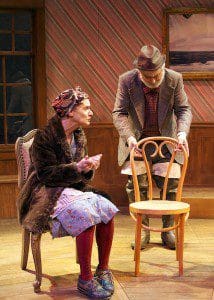
(photo by Sarah Roland).
I heard somewhere that it’s easier to dream lucidly as a couple. If, before going to sleep, you turn to your lover and say, “Darling, tonight let’s dream of boats,” and then you both go to sleep, the odds are much greater that you will both dream of boats.
The Cutting Ball Theater’s production of Eugene Ionesco’s The Chairs (a new translation by Rob Melrose, directed by Annie Elias) is the story of a superannuated couple who create a new reality together as they fight off the tedium and irrelevance of old age. They live in a crumbling apartment building on an island, somewhere—according to The Old Man, Paris was destroyed years ago, if it ever existed at all. Their only contact with the outside world is the music (Edith Piaf or a clone) that crackles through the ancient radio (sound design by Theodore J.H. Hulsker). But since the two are alone onstage for most of the play, even the music might be a shared delusion.
At first, the atmosphere almost makes one sleepy—we slip into what feels like a long-settled routine. David Sinaiko as The Old Man sits onstage gazing out the window as the audience files in. You have the feeling he’s been sitting there for years. Michael Locher’s set is comfortably shabby, with its water-stained pink wallpaper and faded furniture. The Chairs begins slowly—in their first exchange, The Old Woman (Tamar Cohn) begs The Old Man to come away from the window and take a seat in a chair. Reluctantly, he agrees, and the couple edge carefully over to the two chairs in the center of the stage and sit down in the same one, with Sinaiko (kittenish and Keatonesque) on Cohn’s lap. Their clothes (costume design by Sarah Roland) add to the production’s dreaminess. Sinaiko wears absurd thigh-high rubber waders, which contribute to the sluggish physicality of his role, while Cohn flounces about in a fur coat and faded, flowered housedress.
As the two slurp tea with great enthusiasm from imaginary cups, the conversation turns to The Old Man’s shortcomings, and all he could have been in life “if only he’d had any ambition.” The Old Woman assures him that “You could have been chief doctor! Chief king!” Everything’s about to change for them, The Old Man tells his “Poopsie,” because tonight he will call a symposium in their apartment and reveal to the world his Message, capable of saving humanity.Because he can’t express himself well enough, an “orator” has been invited who will interpret the Message.
Almost immediately, the fantasy gets out of control. Overcome with anxiety, The Old Woman begs her husband to call off the meeting.But it’s too late for that—the guests have all been invited. You get the feeling the couple runs through this every night (an intuition that makes a puzzle of the play’s ending). They begin to greet the evening’s “guests,” opening the door on an empty hallway and introducing each other to the lady, the colonel. Though they are obviously helping one other to invent the unique character of each visitor, they can’t seem to control them, and the guests engage in behavior they find disturbing. As each new person arrives, “Poopsie” must run to another room to bring a chair. As the laws of comedy dictate, the guests arrive faster and faster until The Old Woman is reduced to a frantic blur and the stage becomes so crowded with chairs the two can’t even walk.
Meanwhile, we know (from reading the program) that an actual person (Derek Fischer) will eventually appear. Who is this person? Their son? Their landlord? A neighbor? And what is his relationship to the mysterious “orator”? And what will happen to their fantasy when he finally appears?
Soon “Poopsie” is separated from her “lamb” by an unseen throng—pressed against the walls, jostled by their invisible guests, they call out to each other in vain. Anxiety and dread begin to creep in at the edges of the comedy, and eventually, when they’ve topped themselves again and again, each moment more outrageous and hysterical than the last, things reach such a pitch that they can’t be sustained any longer. “Their imagination allows them to live a larger life, but because it literally has no limits it’s also dangerous, like playing in the holodeck with the safety protocols off.
Subtly and easily, Sinaiko avoids the usual sins of actors playing beyond their age (see: Guy Pierce, Prometheus). A little puffy tiredness around the eyes, a little hesitation in the gait. Tamar Cohn as The Old Woman is ancient and ageless—a luminance in her face reminds one of Dianne Weist, but Cohn has a greater range of expression, her features twisting in disappointment and rising in delight. As a comedienne she is more than a match for Sinaiko. They whip each other into a frenzy that at times feels violent but like in the slapstick comedy that inspires the production (director Elias cites Chaplin, Keaton, the Marx Brothers, Laurel & Hardy), kindness and care are always at the center. The union of arbitrary brutality with nearly heartbreaking tenderness is the essence of this type of comedy.
Melrose’s new translation discovers some wordplay passed over by previous, more literal translations of Ionesco’s play. With all the word games and racing around onstage, the play, at times, is more dazzling than laugh-out-loud funny. This doesn’t stop the abrupt transitions from comic topathetic from inducing real-life tears, as at the end, when The Old Man breaks out of his manic recital to call out to his “faithful companion,” reaching out for her across the tangle of empty chairs.
The Chairs runs through April 7 at the EXIT on Taylor, 277 Taylor St., San Francisco
